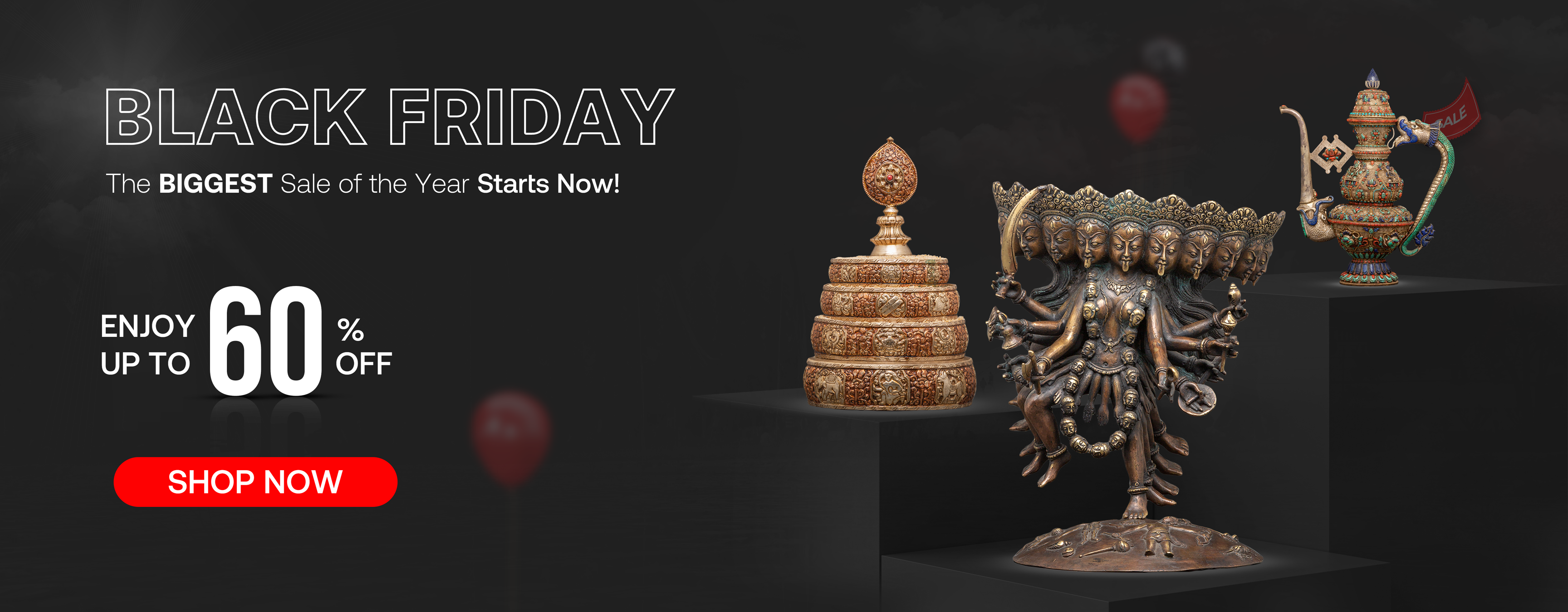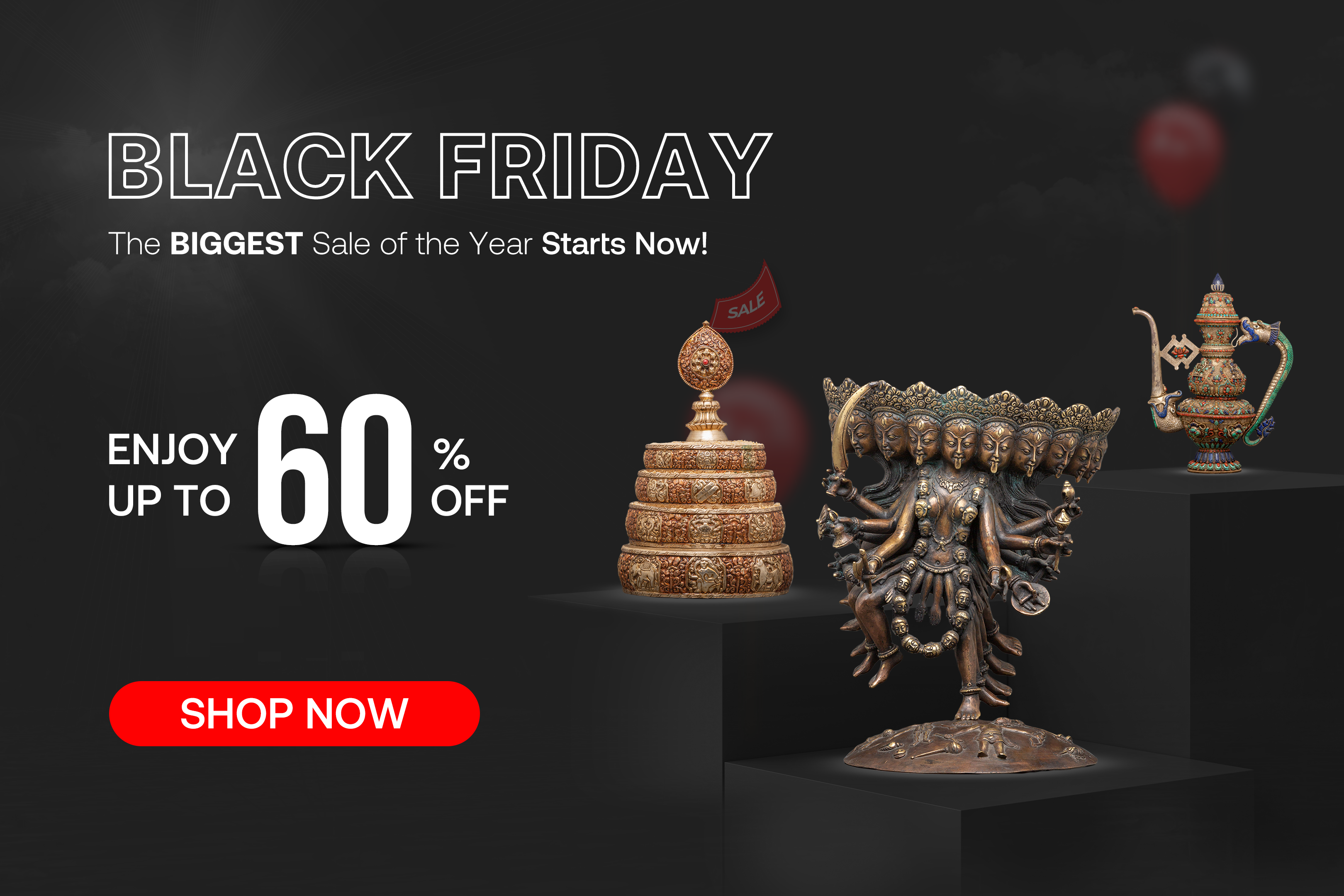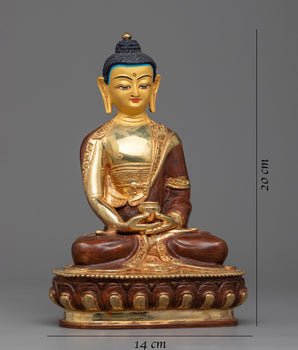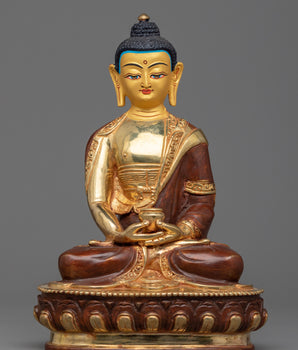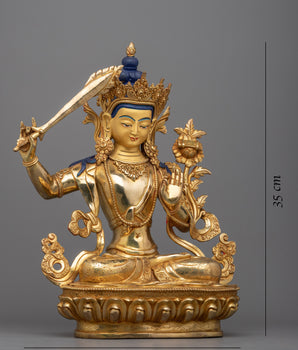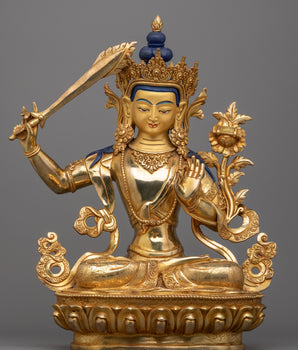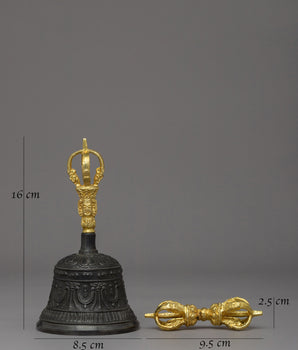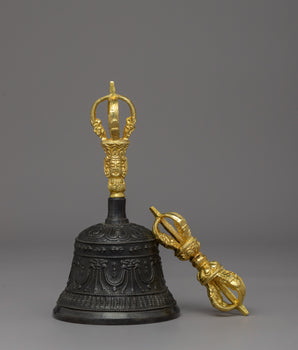Introduction: The Sacred World of Buddhist Ritual Implements
In Vajrayana Buddhism, ritual items are more than spiritual décor — they are sacred tools that embody deep symbolism and support the path to enlightenment. From the thunderbolt-like vajra to the serene offering bowls, each object expresses aspects of compassion, wisdom, and transformation.
At Evamratna, every ritual item is handcrafted by Himalayan artisans, carrying centuries of lineage and blessing. Whether you are building a home altar or deepening your spiritual journey, understanding these sacred implements brings meaning to every gesture of devotion.
What Is Vajrayāna Buddhism?
The term Vajrayāna (Sanskrit: वज्रयान) literally means “Diamond Vehicle” or “Thunderbolt Vehicle.” It is also called Mantrayāna, Tantrayāna, or Esoteric/Secret Buddhism. Vajrayāna is considered a development within Mahāyāna Buddhism, emphasizing more rapid methods (esoteric techniques, mantra, tantra) to awakening.
Where Mahāyāna stresses the Bodhisattva path (compassion, emptiness) gradually, Vajrayāna introduces skillful (sometimes “upaya”) methods, symbolic visualization practices, and ritual techniques believed to accelerate spiritual realization.
Why is Vajrayana Buddhism called Daimond Vehicle?
Vajrayana is often called the Diamond Vehicle because it is a sacred path that emphasizes transformation, visualization, and direct realization. Vajrayana teaches that enlightenment is not distant — it can be realized within this very body and lifetime.
It combines ritual, mantra, meditation, and visualization, transforming everyday experience into a sacred offering. Central to Vajrayana are its ritual implements, which embody wisdom, compassion, and the union of opposites — core teachings of the tradition.
Key Features / Characteristics of Vajrayāna
-
Esoteric / Secret Transmission: Many practices are not publicly taught; they require initiation (empowerment) from a qualified guru.
-
Use of Mantra, Mudra, Mandala: Sound (mantra), gesture (mudra), and sacred diagram/space (mandala) are essential elements.
-
Deity Yoga / Yidam Practice: Visualization and identification with a deity (yidam) is central.
-
Transformation of Experience: Rather than rejecting worldly phenomena, transforms them (sensuality, perception) into path.
-
Rapid Path: Emphasis on methods that compress time, with more concentrated tools and practices.
-
Non-dualism & Emptiness: The doctrine of emptiness is central; form is emptiness and emptiness is form.
-
Three Vajras / Three Bodies / Tantric Correspondences: Use of the trikāya model (enjoyment, transformation, dharmakaya) and correspondences (chakras, subtle body channels) in advanced practices.
Essential Buddhist Ritual Items and Their Symbolism
Buddhist ritual items are sacred tools that embody deep spiritual meanings and serve as instruments for transformation. In Vajrayana Buddhism, these items help practitioners connect with higher realms of awareness, purify the mind, and assist in the journey toward enlightenment. Below are the most important Vajrayana ritual items — their meanings, symbolism, and how they are used in meditation, ceremony, and daily practice.
1. Vajra (Dorje) — The Indestructible Thunderbolt
Symbolism:
The Vajra represents the indestructible nature of truth, embodying both the qualities of compassion (method) and wisdom. The vajra symbolizes the diamond-like nature of reality, which is unshakable and unchanging, despite the appearance of impermanence in the world. It also symbolizes the masculine energy in Vajrayana practice, the power to cut through illusion and reach ultimate truth.
Usage:
In rituals, the vajra is traditionally held in the right hand and paired with the bell in the left hand. It is used to invoke blessings, empowerment, and to represent the practitioner’s commitment to the path of enlightenment. The vajra's sound, its shape, and its significance are designed to help deepen the practitioner’s connection to the transcendent. It is an essential part of Vajrayana rituals, especially during pujas and mantra recitations.
 Read More about Types of Vajra Used in Vajrayana
Read More about Types of Vajra Used in Vajrayana
2. Bell (Ghanta / Drilbu) — The Voice of Wisdom
Symbolism:
The bell represents wisdom, emptiness, and the feminine principle. It is symbolic of the receptive, nourishing aspects of the universe and the heart of enlightenment. The bell’s ringing is associated with the sound of Dharma, which awakens the practitioner to the realization of emptiness and interconnectedness. It is said to symbolize the feminine counterpart to the vajra’s masculine energy, together representing the union of wisdom and method.
Usage:
The bell is usually held in the left hand and rung during mantra recitations or ritual offerings. When used with the vajra, it signifies the balance of wisdom and compassion, reminding the practitioner that both elements must work in harmony for spiritual success. The sound of the bell is also used to clear negative energy and create a sacred, pure space for meditation and practice.

Read More About Traditional Handmade Bell and Vajra
3. Phurba (Kīla) — The Ritual Dagger of Transformation
Symbolism:
The phurba is a three-sided dagger that represents the power to transform negative energies into positive spiritual forces. It is most often used in rituals that aim to subdue harmful energies or obstacles. The phurba is also closely associated with the wrathful deities of Vajrayana, embodying their ability to cut through ignorance and liberate beings from suffering. Additionally, it is said to represent the transmutation of the "three poisons" (ignorance, desire, and aversion) into wisdom.
Usage:
In tantric rituals, the phurba is often used to stabilize spiritual space, pin down negative forces, or consecrate the environment for meditation. The phurba can also be placed in sacred space during ritual to empower offerings and blessings. Practitioners may use the phurba to ritually pin down negative energies that prevent spiritual growth. 
Click here to Learn more about the Phurba: The Ritual dagger
4. Kapala (Skull Cup) — The Vessel of Transcendence
-
Symbolism: The kapala represents the transformation of impurity into wisdom. Traditionally made from a human skull, it symbolizes the impermanence of life and the transformation of attachment to death into spiritual liberation. It is associated with wrathful deities, who use the skull to contain offering substances (e.g., blood, nectar) to transform suffering into enlightened qualities.
The kapala also symbolizes the non-dual nature of reality, where even death is used as an offering to the divine. -
Usage: The kapala is typically used in tantric rituals involving wrathful deities, where offerings are made to transform negative forces. It holds offerings of food, light, and nectar to honor and invoke the deities. It also serves as a reminder to practitioners of the impermanence of material existence and the importance of letting go of attachment.
 Read more about Kapala: The Skull Cup
Read more about Kapala: The Skull Cup
5. Kartika (Ritual Knife) — Cutting Through Ignorance
-
Symbolism: The kartika, or ritual knife, has a curved blade that represents the cutting of ignorance and the severing of attachment. It symbolizes the destruction of illusion, helping to clear the mind of mental distractions and purify delusions. The kartika is associated with feminine wisdom, reflecting the practice of cutting through the false concepts that keep practitioners from realizing their true nature.
-
Usage: The kartika is used in many tantric practices where the practitioner needs to cut through attachments and ignorance. It is often paired with the kapala (skull cup), symbolizing the union of wisdom and compassion in cutting through the three poisons (greed, hatred, and ignorance).
6. Damaru — The Sacred Drum of Sound
Symbolism:
The damaru represents the union of wisdom and compassion through the sacred sound of the drum. The rhythmic beat is thought to symbolize the heartbeats of the universe, maintaining cosmic order and balance. The sound of the damaru is essential for invoking divine energy during mantra recitations and ritual practices.
Usage:
The damaru is typically played during mantra recitations and pujas, where the sound punctuates each prayer or mantra, invoking the divine presence. It is also used to signify the awakening of spiritual energy, and is often paired with the vajra and bell.

7. Offering Bowls — Acts of Generosity
Offering bowls represent the seven offerings given to enlightened beings: water, flowers, incense, light, perfume, food, and music. These offerings symbolize the practice of generosity and the purification of the five senses (sight, sound, touch, taste, and smell). They also represent the transformation of mundane substances into spiritual offerings.
Usage:
Offering bowls are placed in sets of seven on altars or sacred spaces in temples or homes. Each bowl is filled with an offering (often water) and used to purify the environment. During rituals, these bowls help focus devotion and purify negative karma.

8. Butter Lamps — The Light of Wisdom
-
Symbolism: Butter lamps are used to illuminate darkness, symbolizing the dispelling of ignorance and the awakening of wisdom. They represent the clarity of truth that arises from deep meditation and the light of compassion that dispels the darkness of suffering. The butter lamp’s light is a symbol of awakening in a world full of ignorance.
-
Usage: Butter lamps are commonly offered daily in temples, monasteries, and homes. The act of lighting a butter lamp is considered an offering to the Buddhas and Bodhisattvas. It helps to illuminate the practitioner’s path to enlightenment.

9. Prayer Wheels — Turning the Wheel of Dharma
-
Symbolism: The prayer wheel contains mantras like Om Mani Padme Hum and serves as a physical representation of the Wheel of Dharma. Turning the wheel is said to be as powerful as reciting the mantra itself, helping the practitioner accumulate merit and purify negative karma. It symbolizes the eternal cycle of Dharma, which is endless and capable of reaching all beings.
-
Usage: Prayer wheels are often found in temples, monasteries, or carried by practitioners during pilgrimages. Handheld prayer wheels are rotated, and large temple wheels are turned by devotees to accumulate merit and spread blessings.

10. Prayer Beads (Mala) — For Mantra Recitation
-
Symbolism: The mala represents concentration, mindfulness, and the accumulation of merit. Traditionally consisting of 108 beads, a mala serves to help practitioners stay focused during mantra recitations, keeping the mind clear of distractions. It symbolizes the path to enlightenment, with each bead representing a step toward liberation.
-
Usage: Malas are used in meditation and mantra recitation to keep track of the number of mantras chanted. Each bead is counted with a gentle touch of the fingers, keeping the mind engaged while focusing on the meaning of the mantra.

The Role of Ritual Implements in Vajrayana Practice
1. Manifesting Enlightened Energy
Each ritual item corresponds to specific enlightened qualities — for instance, the vajra embodies indestructible awareness, and the bell embodies wisdom.
2. Supporting Visualization Practices
Ritual tools serve as external anchors for visualization, meditation, and deity yoga.
3. Enhancing Concentration and Devotion
Using ritual implements brings the mind, speech, and body into harmony during mantra recitation and puja.
4. Creating a Sacred Space
Altars adorned with butter lamps, bowls, and ritual instruments become a mandala of transformation, elevating consciousness and blessing the environment.
Building a Buddhist Altar at Home
Creating a sacred space at home is an important first step for many practitioners.
Here’s how to begin:
-
Choose a clean, elevated surface facing east if possible.
-
Place an image or statue of Buddha or your chosen deity.
-
Add seven offering bowls filled daily with clean water or symbolic offerings.
-
Include essential implements such as a bell, vajra, and butter lamp.
-
Keep the space tidy and sacred, treating it as a living temple.
Explore altar-ready ritual sets from Evamratna’s Collection →
Conclusion
Buddhist ritual items are gateways to mindfulness and awakening. Each piece — whether a vajra, bell, or lamp — represents aspects of enlightenment and the union of wisdom and compassion.
You can discover authentic handmade ritual implements that are the living expressions of sacred art and practice.






